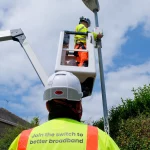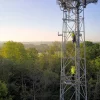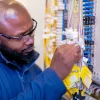Sutton to Boost Mobile Coverage with New Open Access Deals

Residents, visitors and businesses in the South London Borough of Sutton (England) could soon see an improvement in the area’s 4G and 5G mobile (mobile broadband) coverage after the Sutton Council signed two new open access agreements – one with Freshwave and the other with Ontix – as part of their Digital Strategy.
The goal of both agreements appears to be to deploy a new network of 4G and 5G “ready” small cells, many of which will be built on to council-owned assets and street furniture, such as lamp posts. The new network would reflect an open access policy, which means that primary mobile operators like EE (BT), O2 (VMO2), Three UK and Vodafone could then buy access to help deliver their services to consumers.
The caveat is that outdoor small cells often only have fairly limited network coverage, but they can still be extremely useful in high demand areas, such as around busy shopping streets or transport hubs. It can also result in faster mobile broadband speeds for consumers and may help to tackle some existing “not spot” signal areas.
Advertisement
Councillor Sunita Gordon, Lead Member for Resources, said:
“I’m pleased to see us making good progress to improve the digital connectivity within Sutton. This will be a huge boost to residents, particularly those living, working or visiting the so called ‘not-spots’ and will also be a very welcome improvement to our infrastructure for local businesses.”
The first deployments of the new small cells are due to start in the “early 2022” period, although the exact rollout plan and completion date for both builds remains unclear. We’ve already seen similar work take place in Croydon (here), among other parts of the UK.
Mark is a professional technology writer, IT consultant and computer engineer from Dorset (England), he also founded ISPreview in 1999 and enjoys analysing the latest telecoms and broadband developments. Find me on X (Twitter), Mastodon, Facebook, BlueSky, Threads.net and Linkedin.
« Virgin Media O2 UK Scraps Exit Charges for Off Net Home Movers
Netomnia Prep GBP15m FTTP Broadband Rollout for Gravesend »





















































A good idea and one that more councils should take up especially to boost high street trade.
What I suspect this means in reality is that the council has made some money by selling access to council assets to Freshwave and Ontix, both of which hope to recover their investment by selling services to the mobile operators.
If councils really wanted to improve mobile coverage they’d be far better off working directly with the operators. This might not generate revenue directly but would probably result in much more immediate service improvements which would benefit local residents and businesses.
The difficult you have with that is it tends to result in exclusive concession agreements for a specific operator. As I recall, BT (EE) wanted an end to that too, although they didn’t at the time propose a clearly defined alternative:
https://www.ispreview.co.uk/index.php/2019/03/bt-calls-for-open-and-fair-access-to-street-furniture-for-5g-mobile.html
There are limits to how much kit from multiple operators can be placed on certain types of street furniture, so an open access approach via a neutral party / platform might make more sense. The proof will be in whether any MNOs agree to harness the network that gets built.
@MarkJ
Westminster council struck a similar deal (also with Ontix) several years ago so it might be worth checking how that has fared and whether any mobile operators have signed up there.
Doesn’t the Electronic Communications Code allow mobile operators to access the street furniture anyway, without the need to pay an intermediary or to use their equipment?
Most street lighting also have light sensors those days so providing small cell 5G infrastructure is possible, the question is how much of a range would they have and how many would be needed to provide a acceptable level of coverage?
Also how does the technology work compared to normal size infrastructure?
It’s a step in right in the direction as 4G/5G infrastructure should be managed by a Seperate company to the mobile providers and they should be leasing capacity in much the same way that Network Rail owns rail infrastructure and train companies pay NR to be able to run trains